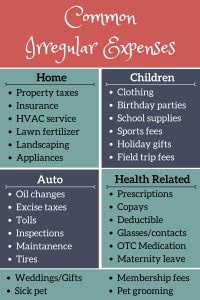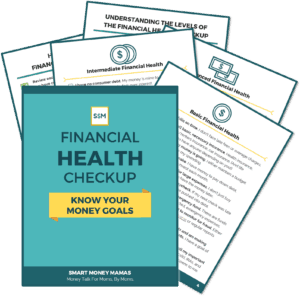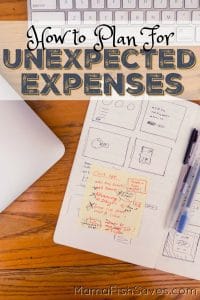There is nothing worse when you are working on keeping a budget than an unexpected expense. You think you’re being responsible, you’re even meal planning (ugh!), and then the car needs new brakes and out comes the dreaded credit card. Back in debt when you thought you were being financially smart! And next, the spiral. For most people, the biggest problem is that once that credit card sneaks out of their wallet once, it becomes much easier for it to keep coming out. So how can you break the cycle? Learn how to plan for unexpected expenses.
Table of Contents
How to Plan for Unexpected Expenses: Avoiding Budget Busters
Luckily, the secret of how to plan for unexpected expenses is surprisingly simple. There are two types: expenses you can predict, and expenses you can’t predict. For the ones you can, start with an annual budget for that item. Then back into what you need to put aside a month to have the money readily available when your son grows out of his shoes again. For the expenses you can’t predict, it is time to finally build that emergency fund.
While it isn’t the most exciting thing you will do in your life, building irregular expenses into your budget is one of the pillars of creating a budget that works long-term. I have written before about my compulsive saver personality, but having a robust budget actually helps me spend. Instead of having a complete meltdown when our HVAC system died 5 months after we bought our home, I wrote a check. That was what the money in the “home maintenance” budget was there for! The unexpected expense became an annoying bump in the road. But it didn’t ruin my summer.
Know What You Know: Considering Irregular Expenses
Every single year the excise tax on Daddy Fish and my cars surprises me. Every. Freaking. Year. We used to live in a state that didn’t have excise taxes on vehicles and somehow I continue to block it out. It drives me nuts that I have to pay the state to own my car when there are tolls every 50 yards. But I digress.
The truth is, most unexpected expenses are just like our excise tax. They aren’t unexpected, just forgotten. The best way to plan for these expenses is to just take the time to think through your common expenses that may not happen monthly as you build your budget.
Creating an Annual Budget
I am a big fan of a flexible monthly budget. For budgeting to last long-term, you need to be forgiving of the changes in spending that happen month to month. However, not all expenses get conveniently billed monthly. When you are initially setting up your budget, it is helpful to think through your annual expenses as well as your monthly ones. What necessary expenses happen every year, even if you don’t know exactly when they will hit?
 To get your mind working, I included some common budget busters on the right. It can help to look back at old credit card statements for what you have spent on these things in the past, but if you are looking to turn over a new leaf I would do some research on what you are willing to pay going forward. There is a lot of data out there on what Americans pay for different products and maintenance services. You can generally get a good sense of what is typical for your area and determine how that relates to your goals.
To get your mind working, I included some common budget busters on the right. It can help to look back at old credit card statements for what you have spent on these things in the past, but if you are looking to turn over a new leaf I would do some research on what you are willing to pay going forward. There is a lot of data out there on what Americans pay for different products and maintenance services. You can generally get a good sense of what is typical for your area and determine how that relates to your goals.
For instance, the average American family spends $624/year or $52/month on clothing for older kids and teens, according to the University of Minnesota Extension. Affluent families pay $936/year or $78/month. Will you commit to only buying your children clothes at clearance sales or do you plan to put your little one in designer jeans? Will your younger child largely wear hand me downs with a few new items? Setting your priorities on these expenses early on will help when your kids grow out of yet another set of clothes!
Utilizing Your Annual Budget
Once you know what you are willing to spend on your various irregular items each year, divide by 12 and review the monthly cost of these items. Make sure that you are still meeting your debt reduction and savings goals in your monthly budget with these added expenses. Even if they are necessities, you may need to circle back and find where you can limit the annual budgets a bit.
After you are happy with where your monthly budget stands, including your categories for irregular expenses, start putting that money aside each month! Each month you don’t use the money in an irregular expense category, just roll the value forward and let it build up. YNAB is set up to do this automatically and in free budget services like Mint you can edit the category to roll balances forward as well.
Once you have it set up, you have to be willing to have some grace with yourself. If you are two months into the process, it is unlikely any of your budget categories are ready for a major expense. When early on you suddenly need $400 new tires when you only have $200 set aside for car maintenance, don’t be afraid to pull from other categories where you aren’t using the funds that month. Then replenish those categories with some of the money you would have allocated to car maintenance in the next months. Life happens! Just because your money is bucketed, it isn’t written in stone.
Know What You Don’t Know: Planning for the Unplannable
Annual budgets are all well and good, but what happens when an unexpected illness keeps you out of work for two weeks? Or your trusty car dies and it will cost more money to fix than replace? Unfortunately, we can’t see the future (otherwise we would all be much richer). We are also just flawed. There will be some expenses that regularly happen that we forget to plan for. That is why you need an emergency fund!
An emergency fund is your financial life jacket. It keeps you from sinking into debt just because you didn’t budget for something. It is easier, cheaper and faster to replenish an emergency fund than to pay down credit card debt for an unexpected expense. The average APR for a credit card as of September 2016 was 13.8%, cash back cards have an average of 20.9%! I don’t know about you, but I would rather put a little bit of money away for an emergency than spend months lining a credit card company’s pockets with high interest payments!
If you don’t have an emergency fund now, I would make it a priority in your budget. I recommend a minimum of $1,000 if you have other debt (before aggressively paying that debt down) then at least $3,000 or 3 months expenses after that. This should be enough to cover most major expenses and protect you from broader money issues.
Protect Your Wallet: Expecting the Unexpected
With a robust monthly budget that accounts for irregular annual expenses and a solid emergency fund, you will have finally broken the paycheck to paycheck cycle! That extra monthly cost once in a while may be annoying, but the annoyance won’t stay with you for months on end. When you know your expenses are planned for and you’re protected from financial potholes in the road, your budget will finally feel freeing instead of restricting! And if setting up this system seems difficult, remember Nelson Mandela’s wise words. “It always seems impossible until it is done.” Good luck!
How do you handle irregular expenses? What expenses pop up that throws off your budget? Let me know!






Our cat just got sick last month and needed a $3,000 vet bill to save her. We save up in mini-buckets like you talked about, but we had to raid a few because we didn’t have enough in our main emergency fund.
But, once we got our tax return back, we were able to pay these buckets back (things like savings for a new car, repairs, etc…), and get our main emergency fund stocked about halfway! Once it’s fully topped off (about 3 months of living expenses total), we’re going to start throwing all of our extra money at debt. w00t! 🙂
Hope your cat is doing alright now! Great story about financial preparedness though!! Thanks for sharing! Good luck with your debt paydown 🙂
Ever since I got a decent handle on my finances, I’ve yet to experience any big wrenches in my planning that threw me off course. I suppose I’ve been lucky in that sense, as I’m far more prepared these days than I was a few years back, but even then, it’ll certainly sting once it happens.
That said, I’m sure some of my neighbours will be complaining that having to shell out a few thousand to replace some pipes running up to the house were both unexpected and budget busting, even if it was announced years back that it was coming. Lesson there being that planning for maintenance probably helps reduce the number of unexpected events ????
It is amazing how many fewer stressful, unexpected events there are when your financial house is in order! Fingers crossed those wrenches keep staying away from you 🙂
Thanks so much for reading and sharing your experiences!!
Planning ahead for unexpected expenses is life changing, seriously. It’s peace of mind when even the possibility of something going wrong comes up, and then more so when that unexpected emergency arises and you can deal with it immediately and avoid stress and debt.
I have numerous “buckets” like you suggest. In fact, I might be a bit of a bucket addict, lol. Everything I can think of might possibly come up, I have a bucket for: home repairs, auto maintenance, medical, etc.